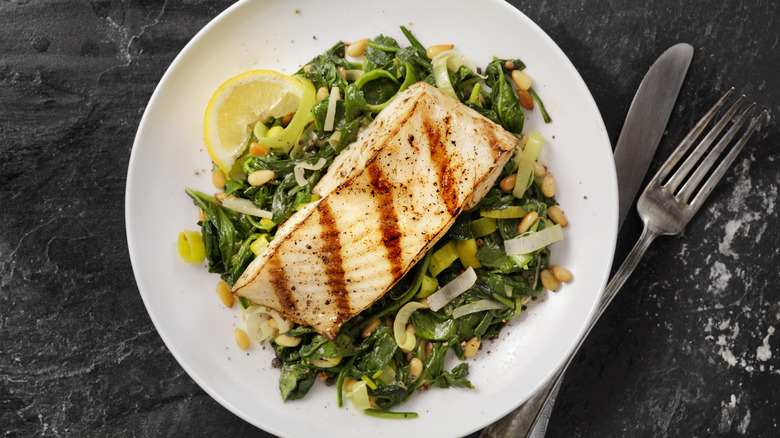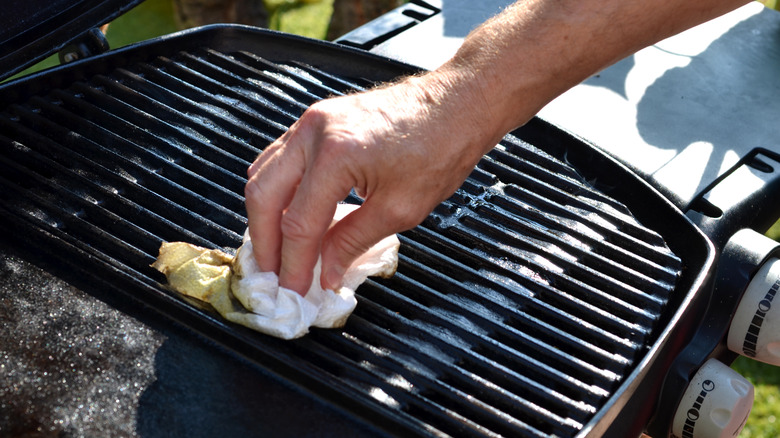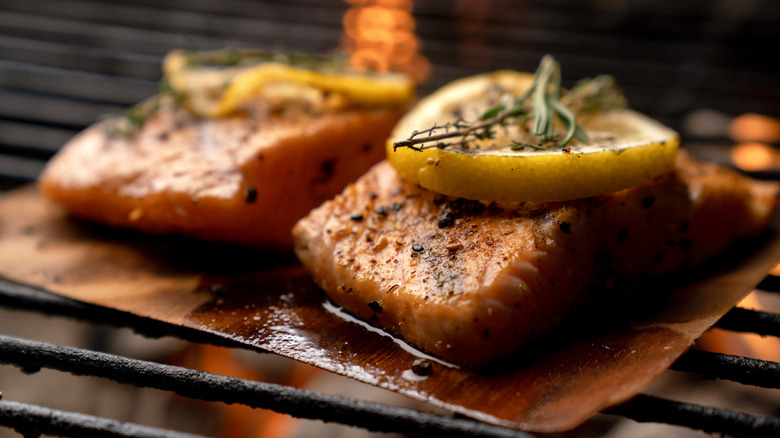The Best Fish Steaks For Grilling Beginners
There are many benefits to outdoor cooking, especially during the warm summer months when we're trying to keep the heat out of the house. Grilling can be a healthy cooking method, letting the excess fat drip off our chops, ribs, and steaks, but when it comes to leaner proteins, like fish, not every type is well suited for the grill.
Sticking to the grill is a primary concern when cooking fish, so thick, firm, and oily varieties are safer options. Grilling newbies should avoid delicate white fish like Dover sole, tilapia, and flounder. While the mild, flaky fish is perfect for deep and pan frying, they can fall apart on an open flame and slip between the grates.
Instead, look for sustainable ½" thick meaty varieties of salmon and snapper and hearty swordfish, tuna, and mahi-mahi (also known as dorado or dolphinfish) steaks that are as delicious as they are easy to grill. When possible, cook the fish with the skin on as an extra layer of protection, as the skin is less likely to stick and holds the fillet together. If you don't mind the fish eyeballing you, grill options like snapper and sea bass whole; just have a fishmonger debone it first.
Preventing the fish from sticking
Always start with a hot, clean grill, as any residue on the grates will increase the odds of the fish sticking. If last night's dinner is still attached, turn the burners to medium-high, scrap the grates once hot, and lightly oil them with a rag. A little water on a hot grate and a stiff brush will help lift any stuck-on food, like deglazing a pan.
Once clean, the fish can be cooked directly or indirectly on the grill. Thick steaks like tuna and swordfish do well cooked directly on the grill, while thinner fillets could use an insurance policy. The firm steaks will benefit from a light coating of a neutral oil before cooking but should release easily once seared. Traditionally served medium-rare, tuna only requires a quick sear, so it's an easy, quick option for grilling beginners. Thick steaks can also be cut into cubes and skewered for kabobs.
Thinner skinless fillets, like snapper, can also be brushed with mayonnaise before placing directly on the grill. Made from egg yolks and oil, the fat provides a nonstick surface on skinless fillets, which are more likely to stick than the skin without affecting the flavor. To create a layer of protection between the grill and the fish, home cooks can also use citrus slices, cedar planks, parchment paper, or aluminum foil.
Grilling insurance policies
On a hot grill, create a bed of thinly sliced overlapping lemons, limes, or oranges (about four). Place the seasoned fish directly on top, and cover the grill. Not only does the citrus prevent the fish from sticking, but it also imparts lots of flavor. You don't need to flip the fish; It's done once it's opaque and will be moist and delicious but lack grill marks.
Cedar planks are an inexpensive option for grilling fish like salmon. The wood imparts a smokey taste and doesn't stick to the salmon. Although you can wash and reuse the planks multiple times if they are in good shape, the wood absorbs what you cooked on it and loses essential oils so that it won't be the same after the initial meal.
Fish can also be steamed in parchment paper or aluminum foil pouches on the cool side of the grill. Place fillets on a 15" long sheet of parchment paper or foil and season with sea salt, lemon, and herbs (or whatever you like). Make a pouch by folding half the parchment over the fish and crimping the edges to keep the steam in. Close the lid, and within 10 to 12 minutes, the fish will be flaky, opaque, and moist.
Finally, use the grill as you would the stove and cook the fish on a cast iron pan. Allow the pan to heat thoroughly before adding the fish, skin-side up. While you'll have another dish to clean, you won't have to worry about fish odors lingering in the house.



